California is home to a wide variety of birds, ranging in size and appearance. However, when it comes to the largest flying birds in California, exactly what species make the cut? Below, discover the 15 largest flying birds in California.
Before reading, it is important to note that this list includes only species native to California, not accidental species or introduced species. These species may be larger than some of those on this list, but they are not native to the area. Ready to learn more? Let’s dive in.
1. California Condor
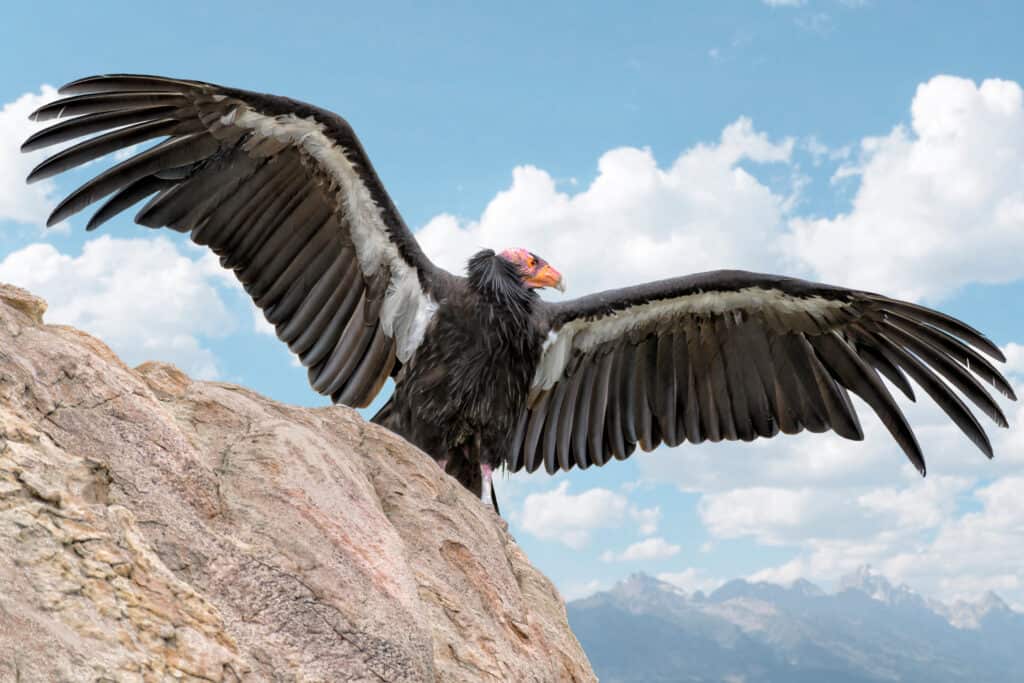
California condors have a 9-foot wingspan.
©Barbara Ash/Shutterstock.com
The California condor (Gymnogyps californianus) is the largest bird in all of North America. It is currently listed as a critically endangered species. In 1987, it became extinct in the wild as the remaining individuals were captured and brought into captivity. Today, this marvelous species’ numbers are on the rise. However, it will still take time and effort before we see these birds as numerous as they were before. Lead poisoning is listed as the largest threat to the California condor.
California condors can grow to an impressive size. As adults, their wingspans can measure up to 109.1 inches. They can grow to be between 46.1 and 52.8 inches in length, and they can weigh up to 349.2 ounces. They sport black plumage with a white underside for the wings, as well as the typical vulture/condor bald head. It can take up to 8 years for an individual to receive their adult coloration.
In California, they have been reintroduced to the southern and central regions. With only a few dozen individuals in the wild, they can be a rare sight.
2. American White Pelican
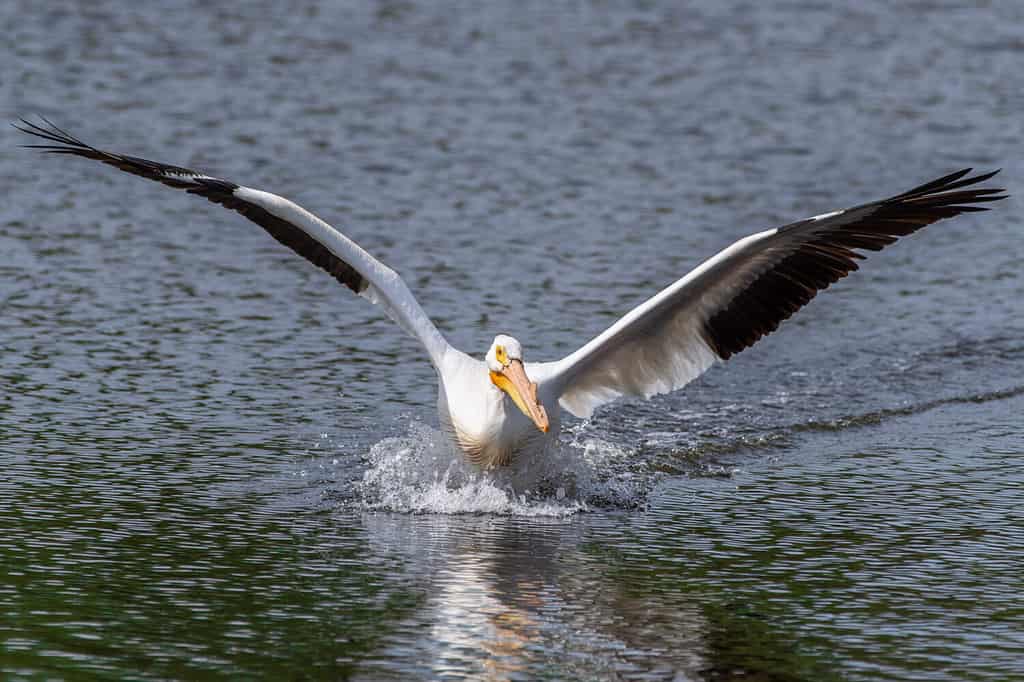
The American white pelican can grow to have a wingspan of over 114 inches, or around 9.5 feet!
©Mike Lynds/Shutterstock.com
Along with the California condor, the American white pelican (Pelecanus erythrorhynchos) is one of the largest birds in North America. As a result, it is also one of the largest flying birds in California. Their wingspans range between 96.1 and 114.2 inches. As for length, American white pelicans can grow to measure 50.0 to 65.0 inches while weighing 158.7 to 317.5 ounces.
Overall, the American white pelican has a primarily white plumage. When fully extended, black flight feathers are visible on the tips of their wings. In a striking contrast, their legs and bills are a bright yellow-orange coloration. They also have a small patch of ornamental feathers that may turn yellow in the spring. Along with this change, during the breeding season, adults will grow a large, rounded projection on the upper mandible.
American white pelicans are a migratory species. They can be found throughout much of California. During the breeding season, they are found further in the northern, along the northeasternmost border of the state. They winter in the south, being spotted through the central region of the state during migration.
3. Canada Goose
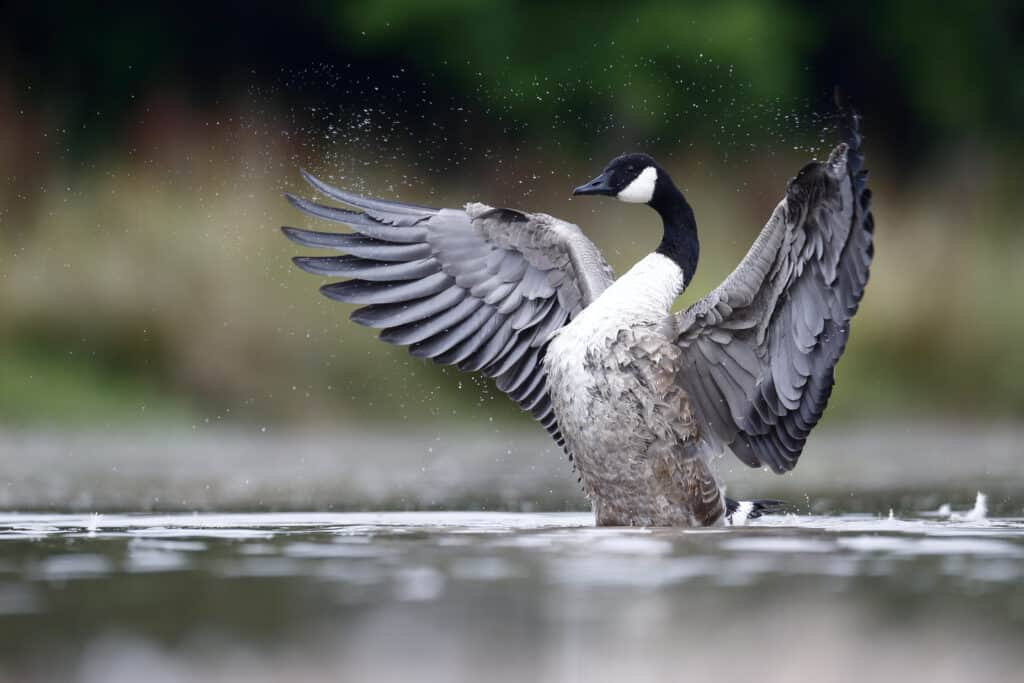
Canada geese may flap their long wings as a sign of aggression.
©Erni/Shutterstock.com
The Canada goose (Branta canadensis) is a common species throughout much of North America. They can be found in almost every region of California, excluding the Sierra Nevada region, during the winter. These geese can be found in a variety of habitats, so long as they are near water.
While the Canada goose isn’t nearly as large as the California condor or the American white pelican, they are still one of the largest flying birds in California. Adults of this species can grow to a length of 29.9 to 43.3 inches. They can also weigh between 105.8 and 317.5 ounces. As for their adult wingspans, these can range from 50.0 to 66.9 inches.
The Canada goose is a striking species, easily distinguished from most other species. They have long necks and large bodies, and they sport beautiful black and brown plumage with white markings.
4. Bald Eagle

One of the largest flying birds in California is the national bird of the United States!
©PHOTOOBJECT/Shutterstock.com
The bald eagle (Haliaeetus leucocephalus) is the national bird of the United States. They can be found throughout the entirety of the state of California, both as a year-round residential species and as a migratory species. The central and southern regions of the state act as wintering grounds for this magnificent species, while the north hosts bald eagles all year.
Bald eagles typically resided in wooded areas near water, preferring to avoid developed areas such as suburban and urban neighborhoods. However, despite their preference to stay away from human activity, they are tolerant of humans when it comes to feeding. As a result, they can often be seen hunting fish near dams. They can be identified by their brown plumage, yellow bill and legs, and white head.
They have a length of 27.9 to 37.8 inches and weigh 105.8 to 222.2 ounces. Their wingspan measures an impressive 80.3 inches.
5. Golden Eagle
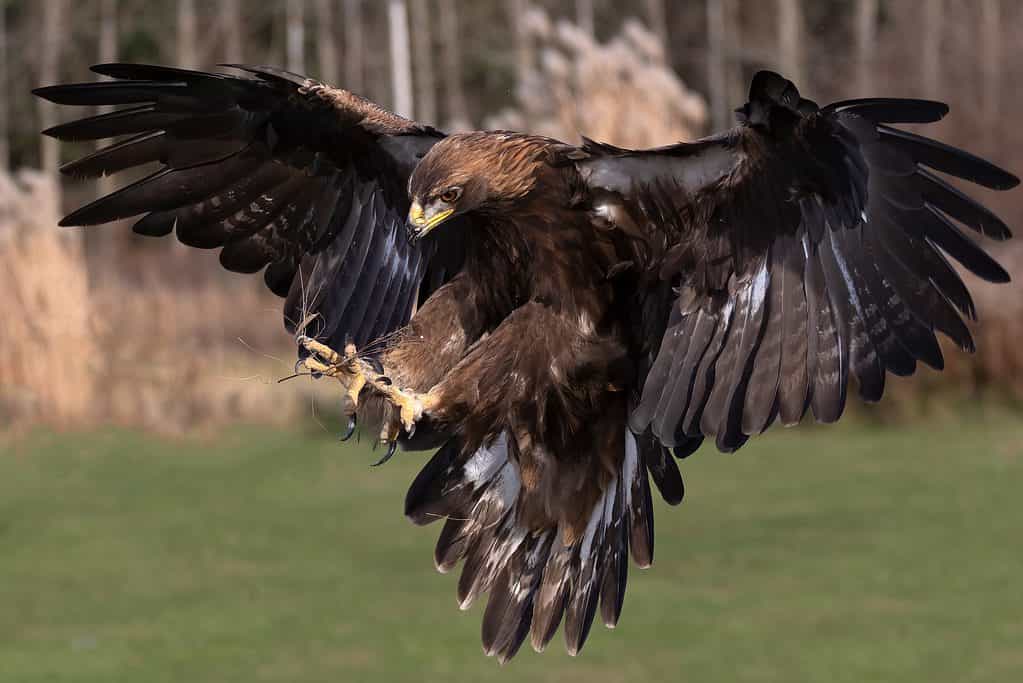
This large bird is named for the golden sheen on the back of its head.
©Touched by light images/Shutterstock.com
The golden eagle (Aquila chrysaetos) is the most widely distributed eagle in North America. They are the national bird of Mexico. They are also one of the largest flying birds in California. On average, adults will grow to a length of 27.6 to 33.1 inches. Their heads are small, with the tail feathers projecting farther in the back than the head in the front. They weigh between 105.8 and 216.1 ounces. Their wingspan measures between 72.8 and 86.6 inches. This gives them a larger wingspan than many of the species on this list that are larger in length or weight.
Golden eagles are dark brown. They are named for the golden sheen along the back of their heads and necks. As juveniles, they will sport defined white markings at the base of the tail and wings. This will fade into adulthood.
These eagles are year-round residents throughout much of California, wintering in the regions where they are not.
6. Sandhill Crane
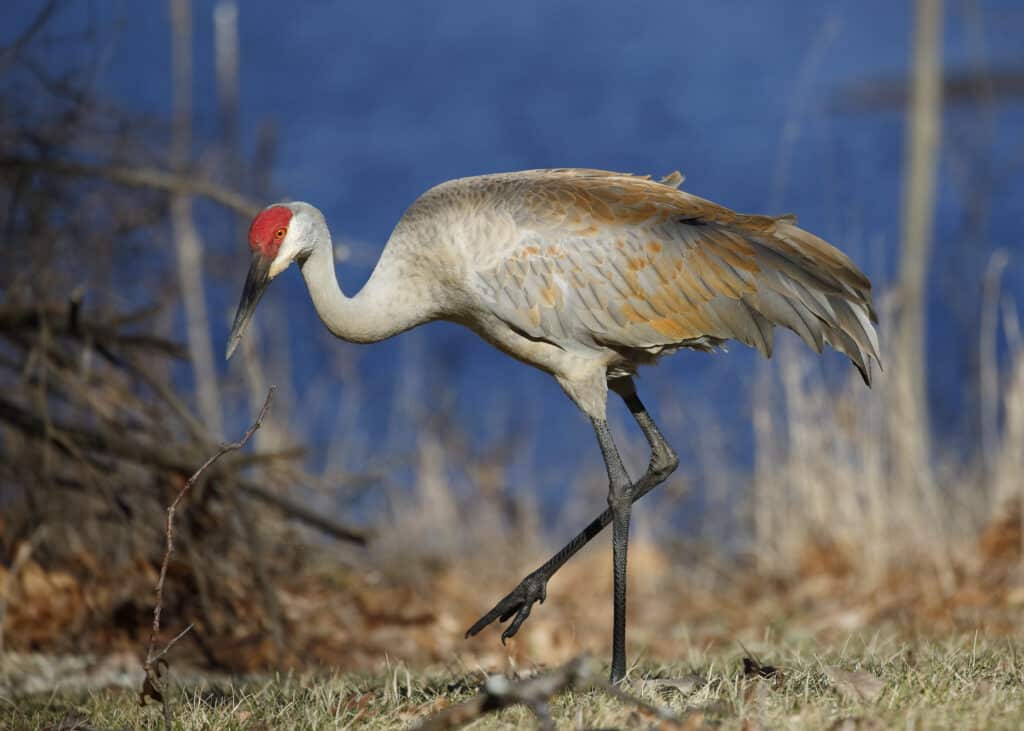
The sandhill crane appears like it is walking on stilts with its long legs!
©Brian Lasenby/Shutterstock.com
Sandhills cranes (Antigone canadensis) are a rarer species than some of the other largest flying birds in California. They are not a year-round resident, and their areas within the state are limited. They breed in the northeasternmost region of California, and they winter in the central region. Sandhill cranes grow to a length of around 47.2 inches. They often weigh between 119.9 and 172.8 ounces, and they sport an average wingspan of 78.7 inches.
In the regions of California where sandhill cranes live, you can most often find them in wetlands near woodlands. During the breeding season, they will build their nests in areas such as marshes and bogs. When the winter comes, you can expect to find them near ponds and lakes at night. However, they are most often seen feeding in grasslands and pastures during the day.
Sandhill cranes have a heavy build with drooping feathers off their back end. They are grey, with rust- and slate-colored markings. They can be best identified by the red skin surrounding their eye and their pale cheek.
7. Brown Pelican
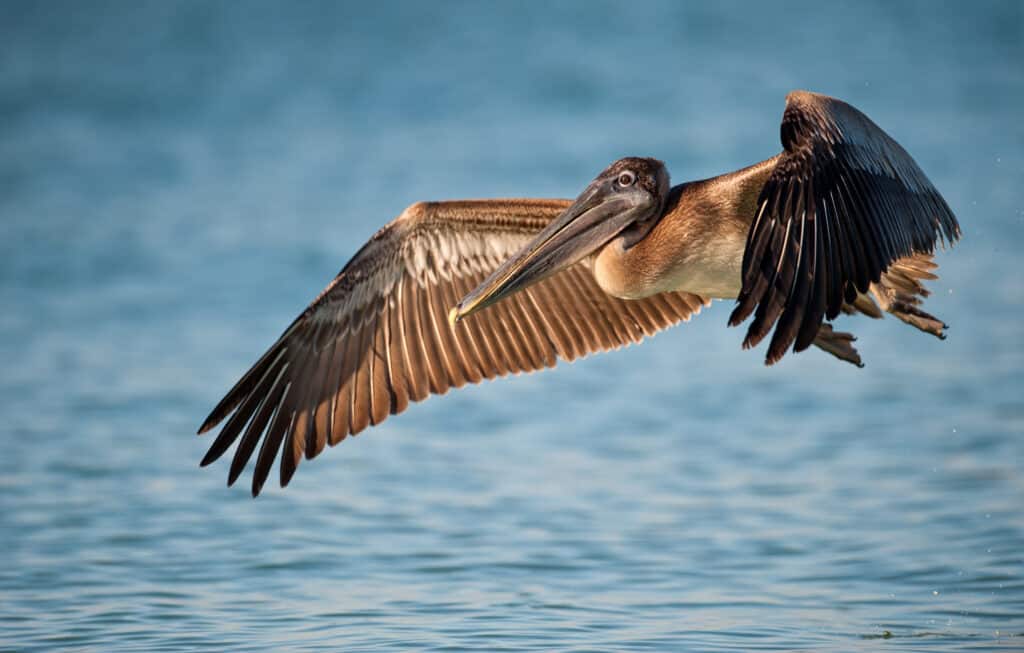
Brown pelicans have a wingspan of more than 7 feet!
©Nagel Photography/Shutterstock.com
Like the sandhill crane, the brown pelican (Pelecanus occidentalis) is a much rarer species of bird found in California. In fact, unless you take to the coast, you may live in California your entire life and never see a brown pelican. This is because brown pelicans spend the entirety of their year in estuaries and similar marine habitats on the shore. They can be found year-round in southern California, with wintering grounds along the rest of the coast.
Despite being named the brown pelican, these amazing birds aren’t entirely brown. Instead, they are named for the brown pouch of skin breeding adults possess. In the Atlantic, this skin is instead red, but the name remains. They have gray-brown bodies with white necks and pale yellow heads. In some individuals, the yellow coloration may seem entirely white.
Brown pelicans rarely take to inland territories. Instead, you’re most likely to see them dotting small offshore islands. Adults grow to reach an average length ranging between 39.4 and 53.9 inches, with a weight of 70.5 to 176.4 ounces. They have an average wingspan of 78.7 inches.
They are the official state bird of Louisiana.
8. Great Blue Heron

Great blue herons are the largest species of North American herons.
©Brian Lasenby/Shutterstock.com
The great blue heron (Ardea herodias) is a common heron species. It is also the largest of all North American herons. These massive birds are found year-round in most of California, with exceptions only in the central region of the state as well as the Sierra Nevada region. In these areas, the great blue heron is seen only in migration.
As not only one of the largest flying birds in California but the largest North American heron, these birds sport impressive measurements. Adults of this species will grow to a length of 38.2 to 53.9 inches. Less bulky than other similar species, they only weigh between 74.1 and 88.2 ounces, however. The length of their wingspan is variable, ranging between 65.8 and 79.1 inches.
Great blue herons can be found in both saltwater and freshwater ecosystems. They may also forage in grasslands. Their diet includes fish, amphibians, reptiles, insects, and small mammals. They use their sharp bills to impale larger prey.
9. Great Horned Owl
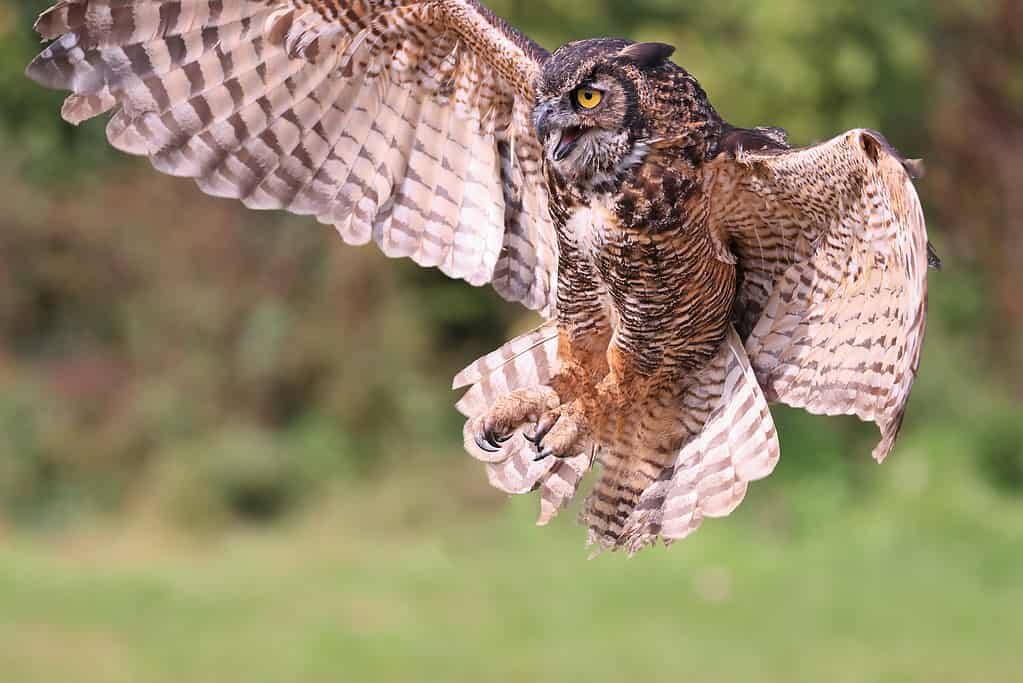
The great horned owl is one of the larger species of owls, as well as one of the largest flying birds in California.
©Vladone/iStock via Getty Images
Great horned owls (Bubo virginianus) are also known as tiger owls or hoot owls. These mighty predators are a year-round resident of much of the United States, including all of California. However, their nocturnal lifestyle means that they may be a rare sight.
The great horned owl is a large, stocky species. Adults grow to a length of 18.1 to 24.8 inches, with a weight of 32.1 to 88.2 ounces. Their large, silent wings can grow to an average wingspan of 39.8 to 57.1 inches.
These owls will choose their territory in areas that sport both forested regions and open spaces. This provides them with protection as well as areas where they can easily hunt for small mammals and similar prey. However, you may also find them in suburban or even urban areas. This can include parks and cities.
10. Ferruginous Hawk
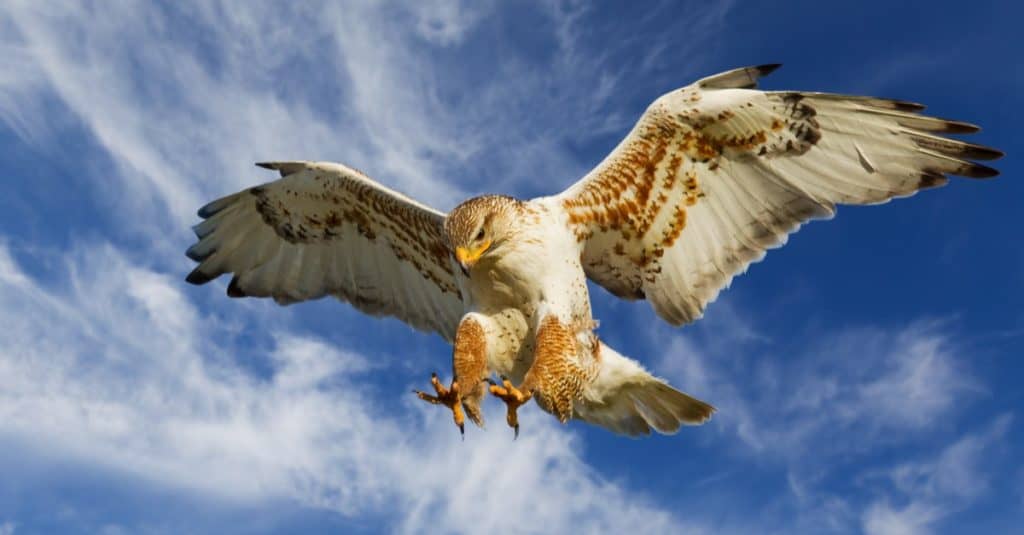
Ferruginous hawks are one of the largest species of hawks.
©Stephen Mcsweeny/Shutterstock.com
The ferruginous hawk (Buteo regalis) is a large bird of prey in California. They are larger than the great horned owl in terms of length (22.1 to 27.2 inches) but smaller in weight (34.5 to 73.2 ounces) and wingspan (52.4 to 55.9 inches).
This migratory species possesses a small habitat range in the United States compared to other species. Although they may be seen year-round in regions of the country, in California, they are a winter species only. You can expect to see these large hawks in the southern and central regions of the state, although they are scarce on the southwesternmost coast. They inhabit rural, open areas.
11. Osprey

Like other raptors, osprey often carry fish in their talons to a place where they can safely consume it.
©Gregory Johnston/Shutterstock.com
The osprey (Pandion haliaetus) can be found throughout all of California. However, as both a year-round and a migratory species, they may inhabit different areas at different times of the year. Ospreys live year-round in the northwesternmost region of the state. Along the southern coast, they can be found during their wintering months, with their breeding range making up the northeasternmost extent of the state. Elsewhere in California, ospreys can be spotted during migration.
These fish-eating raptors can achieve a maximum length of 22.8 inches in adulthood, with an average weight of 49.4 to 70.5 ounces. They sport an impressive wingspan, however, ranging between 59.1 to 70.9 inches.
12. Great Egret

Great egrets can reach over three feet in length.
©iStock.com/CreativeNature_nl
Although smaller than the great blue heron, the great egret (Ardea alba) is still one of the largest flying birds in California. As a year-round resident in the central region of the state and a winter visitor along the coastline, this species is also a staple in California’s wetlands and marshes. Their white plumage provides a striking contrast to their environment, along with their yellow, dagger-like bill and black legs.
Great egrets are tall, with long legs. They reach a length ranging between 37.0 and 40.9 inches, and adults can weigh as much as 35.3 ounces. Their wingspan measures 51.6 to 57.1 inches.
13. Turkey Vulture

Turkey vultures are known for their supersized wingspans that can reach over 70 inches.
©GarySang/Shutterstock.com
Of all New World vulture species, the turkey vulture (Cathartes aura) is the most widespread. It is also one of the largest flying birds in California, though not nearly the size of the California condor. These birds have an easy-to-identify flying pattern. This is because not only do they fly with outstretched feathers resembling fingers, but they also hold their wings in such a way that they resemble a “V” shape.
Turkey vultures are known for their impressive wingspans, which average between 66.9 and 70.1 inches. As for length, they measure around 25.2 to 31.9 inches, and they weigh an average of 70 ounces.
14. Rough-Legged Hawk
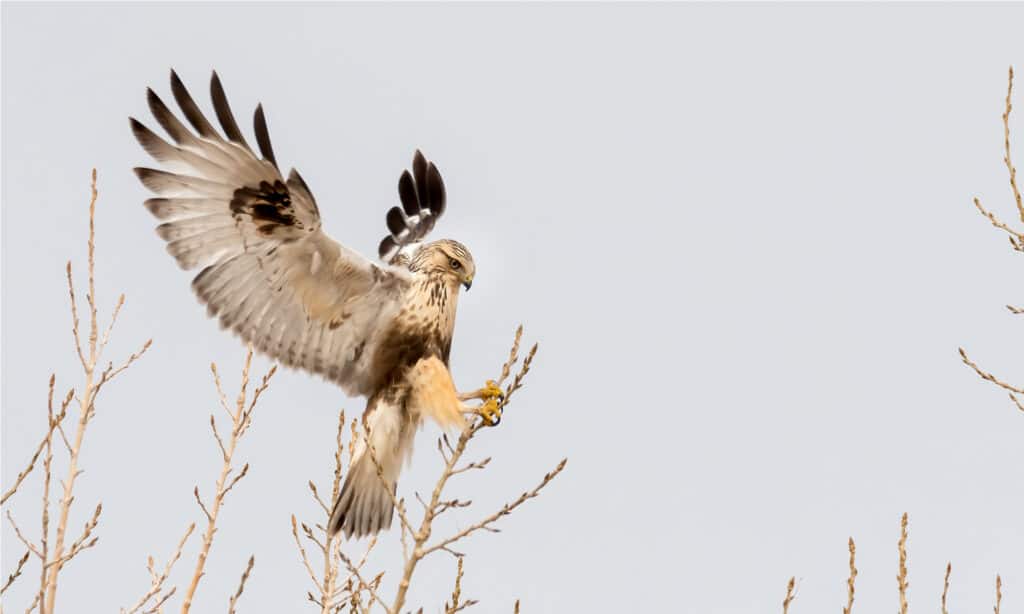
Rough-legged hawks can be seen in eastern California during the winter months.
©Eivor Kuchta/Shutterstock.com
The rough-legged hawk (Buteo lagopus) is also known as the rough-legged buzzard. The name used depends on region, with North America and Europe using each respective term. As a result, in California, you’re likely to know this bird by hawk rather than buzzard. These large raptors aren’t common in California, only being seen in the eastern part of the state in the winter.
Rough-legged hawks can grow to be up to 20.5 inches in length, with a maximum adult weight averaging about 49.4 ounces. Their wingspans measure 52.0 to 54.3 inches.
15. Glaucous-Winged Gull

The glaucous-winged gull has a wingspan that can be more than double its body length.
©Nick Pecker/Shutterstock.com
When you think of the largest flying birds in California, a gull may not be the first species to come to mind. However, as far as native species in the state go, the glaucous-winged gull (Larus glaucescens) is actually a top contender thanks to its large and heavyset body.
The glaucous-winged gull grows to reach a length ranging between 19.7 and 23.2 inches. Their wingspan can equal more than double this, reaching up to 56.3 inches. These gulls weigh around 31.8 to 42.3 ounces.
As with many species of gull, the glaucous-winged gull cannot be found inland. Instead, in California, you will only find this bird wintering along the coast.
The photo featured at the top of this post is © George Lamson/Shutterstock.com
Thank you for reading! Have some feedback for us? Contact the AZ Animals editorial team.






